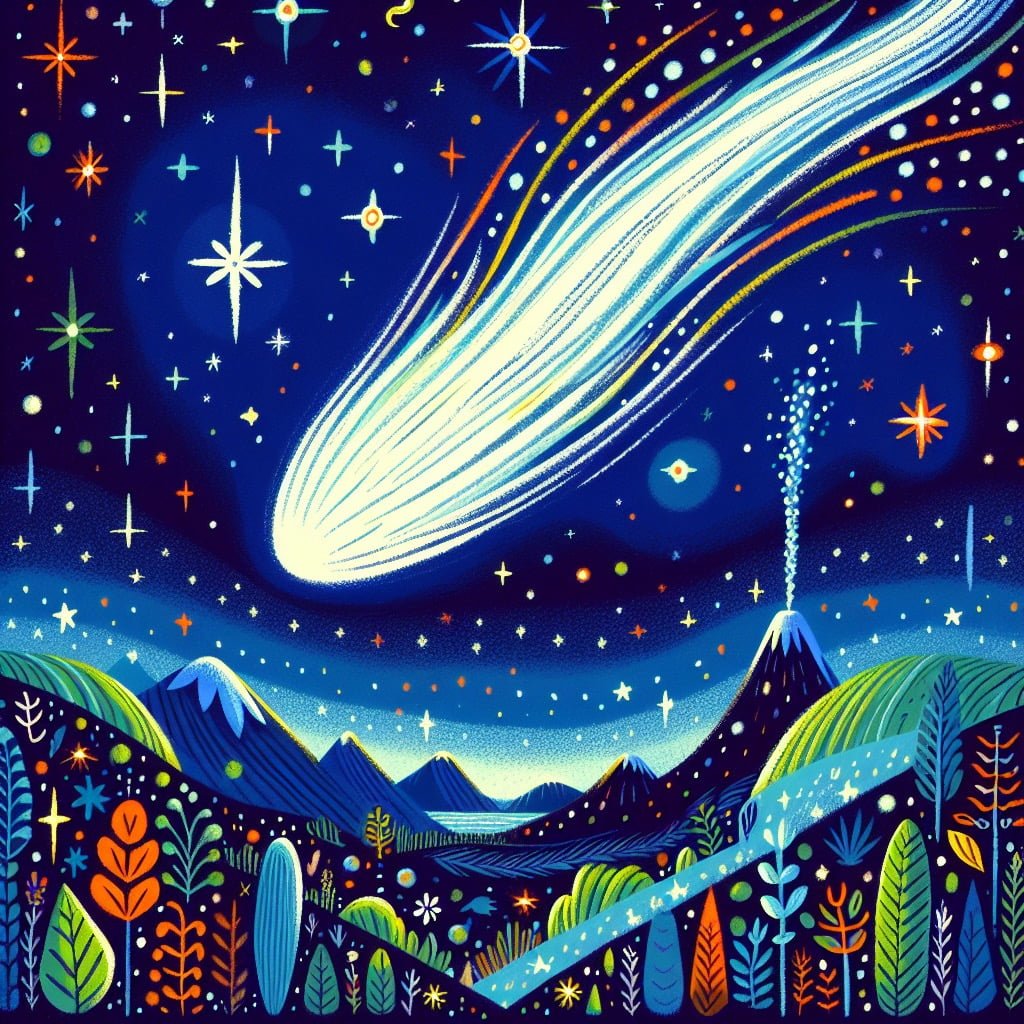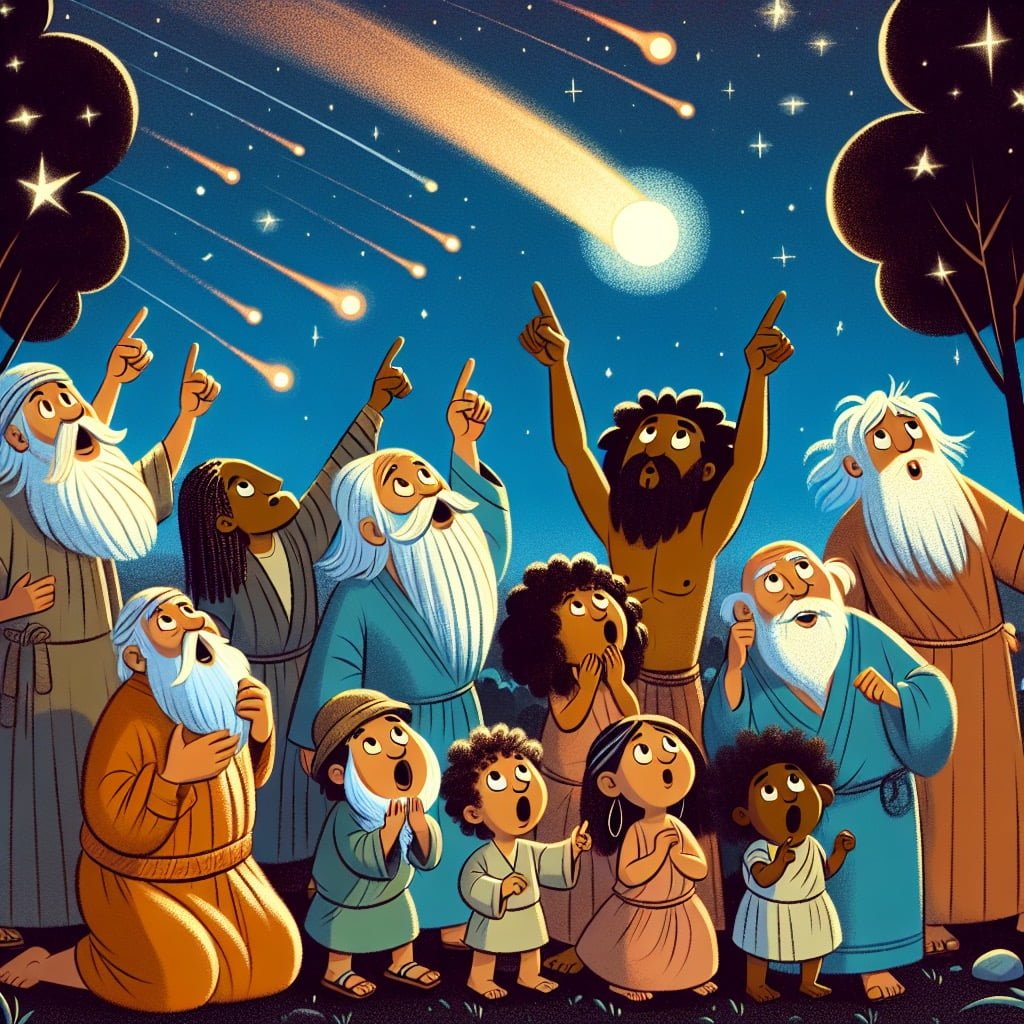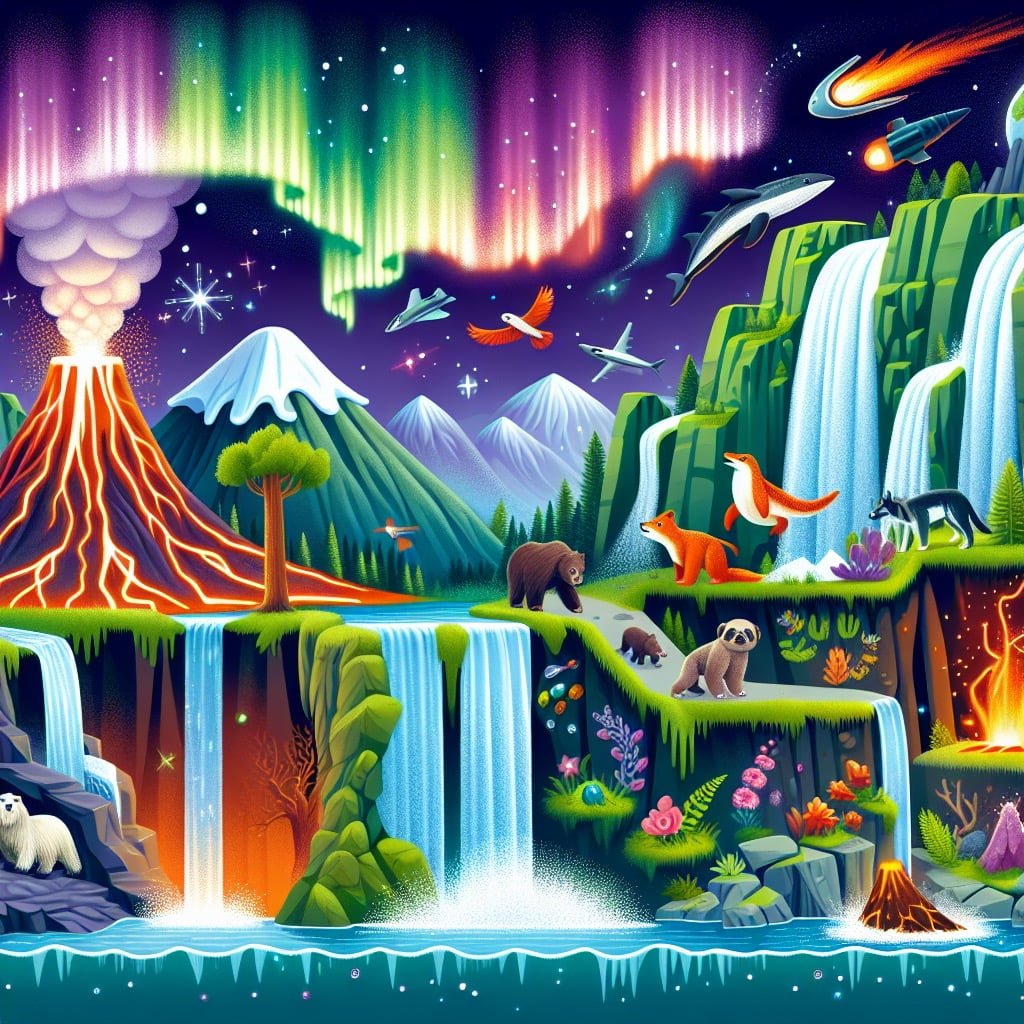Welcome to a world of fascinating Comet Facts For Kids! As an expert in the field of astronomy, I am thrilled to take you on a journey through the captivating world of comets. These icy bodies, often referred to as “dirty snowballs,” hold secrets about the early solar system and have inspired awe and wonder throughout history. From the composition of comets to their unique behavior and origins in the Kuiper Belt and Oort Cloud, there is so much to discover about these celestial objects. So join me as we dive into the fun and educational facts about comets that will spark curiosity and inspire a lifelong love for science and exploration. Let’s unravel the mysteries of the universe together!
Comet Facts For Kids
1. Comets Are Made of Ice and Dust

For younger kids: Comets are like giant snowballs in space!
For older kids: Comets are composed of frozen gases, water, dust, and rocky particles. As they approach the Sun, the ice starts to vaporize, creating the signature glowing tail.
Detailed explanation:Comets are fascinating objects in our solar system that captivate the imagination of both kids and adults alike. One of the most intriguing Comet Facts For Kids is that comets are primarily composed of ice and dust.
Comets are often referred to as “dirty snowballs” due to their composition of frozen water, carbon dioxide, methane, and ammonia mixed with dust particles. These icy bodies originate from the outer regions of the solar system, where the temperature is extremely cold, allowing water and other volatile substances to freeze and form solid chunks.
As a comet approaches the Sun, the heat causes the ice to sublimate, turning directly from a solid into a gas. This process creates a bright coma, or cloud of gas and dust, around the nucleus of the comet. The pressure from the solar wind and radiation then push this material away from the comet, forming the distinctive tails that comets are known for.
Studying comets provides valuable insight into the origins of the solar system and the processes that occurred during its formation. By analyzing the composition of cometary material, scientists can learn more about the conditions that existed in the early solar system, as well as the role comets may have played in delivering water and other organic compounds to Earth.
Overall, comets are a fascinating example of the delicate balance between ice and dust in the far reaches of the solar system, and studying them can teach us a great deal about the history and formation of our own planet.
Comet Facts For Kids
2. A Comet’s Tail Always Points Away from the Sun

For younger kids: Comets have long, shiny tails that point away from the Sun.
For older kids: The tail of a comet is created when gases and dust particles are pushed away from the Sun by solar radiation, forming a long tail that always points in the opposite direction of the Sun.
Detailed explanation:Comet Facts For Kids
One fascinating fact about comets that always captures the attention of children and adults alike is that a comet’s tail always points away from the sun. This unique phenomenon is due to the interaction between the comet and the solar wind, which consists of charged particles emitted by the sun.
As a comet travels through space, it encounters the solar wind, which exerts a force on the comet’s nucleus and pushes material away from the sun. This material forms the comet’s tail, which can extend for millions of kilometers in the opposite direction of the sun. The tail is composed of dust particles and gases released from the nucleus of the comet as it heats up and undergoes sublimation.
The process of sublimation occurs when the comet’s icy nucleus heats up as it approaches the sun, causing the solid ice to turn directly into gas without passing through the liquid phase. This gas, along with dust particles, is then swept away from the sun by the solar wind to create the iconic tail that we associate with comets.
Comets have been observed and studied for centuries, with some of the most famous comets such as Halley’s Comet returning to the inner solar system periodically. By studying comets, scientists can learn more about the early solar system and the conditions that existed billions of years ago. Overall, the unique phenomenon of a comet’s tail always pointing away from the sun provides a captivating glimpse into the dynamic interactions that take place in our solar system.
In conclusion, the fact that a comet’s tail always points away from the sun is just one of the many fascinating Comet Facts For Kids that highlight the beauty and complexity of the universe.
Comet Facts For Kids
3. Halley’s Comet Returns Every 76 Years

For younger kids: Halley’s Comet is a special visitor to our sky that comes back every 76 years!
For older kids: Halley’s Comet, one of the most famous comets, completes its orbit around the Sun approximately every 76 years, and its last appearance was in 1986. It won’t return until 2061.
Detailed explanation:Comet Facts For Kids: Halley’s Comet, named after the astronomer Edmond Halley who first predicted its return, is one of the most famous comets in the night sky. This comet has a highly elliptical orbit that takes it close to the sun and then out towards the outer reaches of our solar system, where it spends most of its time. Its orbit brings it back around to the inner solar system approximately every 76 years.
Halley’s Comet is visible from Earth with the naked eye, making it one of the few comets that can be easily seen without the aid of a telescope. The last time it was visible from Earth was in 1986, and it is expected to return around the year 2061. Its appearance is always a highly anticipated event among astronomers and stargazers alike, as it is one of the most predictable comets in terms of its return.
Comets are made up of ice, dust, and rocky material that form a glowing coma (atmosphere) and a tail when they approach the sun. Halley’s Comet is no exception, and its bright tail is a stunning sight in the night sky. For kids interested in astronomy, learning about Halley’s Comet can be a fascinating introduction to the wonders of space. Its regular reappearance gives scientists the opportunity to study its composition and behavior, providing valuable insights into the formation and evolution of our solar system.
Comet Facts For Kids
4. Comets Can Have Long or Short Orbits

For younger kids: Some comets stay in space for a long time, and some visit us quickly!
For older kids: Comets have diverse orbits; some take thousands of years to complete one orbit, while others have short periods and can return in just a few years.
Detailed explanation:Comets are celestial objects that have captivated the imagination of humans for centuries. One fascinating aspect of comets is their orbits, which can vary widely in length. Some comets have long orbits that take them hundreds or even thousands of years to complete, while others have short orbits that only take a few years or even months to circle the sun.
Comet Facts For Kids show that the length of a comet’s orbit is determined by its distance from the sun and its speed. Comets that originate from the Kuiper Belt or the Oort Cloud, two regions of icy debris beyond the orbit of Neptune, tend to have long orbits because they are farther away from the sun. These comets may only visit the inner solar system once in a lifetime, leaving a trail of debris that can be seen as meteor showers on Earth.
On the other hand, comets that originate from the asteroid belt between Mars and Jupiter or from the inner solar system tend to have short orbits because they are closer to the sun. These comets may return to the inner solar system every few years or even months, putting on spectacular displays as they pass by Earth.
Studying comets with long and short orbits can provide valuable insights into the origins of our solar system and the processes that shape it. By understanding the dynamics of these icy wanderers, scientists can learn more about the formation of planets, the evolution of the solar system, and the potential threats posed by near-Earth comets. So next time you look up at the night sky and see a comet streaking across, remember that it could be on a long journey through the cosmos or just passing by for a quick visit.
Comet Facts For Kids
5. Comets Have Been Known Since Ancient Times

For younger kids: People have been seeing comets for a really, really long time!
For older kids: Comets have been documented by civilizations throughout history, with some records dating back to ancient Mesopotamia, Egypt, and China.
Detailed explanation:Comet Facts For Kids have always fascinated people since ancient times. These celestial objects have been observed and documented by various cultures throughout history. Comets are made up of a combination of ice, dust, rock, and organic compounds, giving them a distinctive glowing tail when they approach the sun.
One of the most famous comet sightings in history is Halley’s Comet, which is visible from Earth about once every 75 years. This comet has been recorded by ancient civilizations such as the Chinese, Babylonians, and Greeks. In fact, the first recorded sighting of Halley’s Comet dates back to 240 BC in China.
Comet Facts For Kids were often seen as omens or signs of impending doom in ancient times. Cultures believed that the appearance of a comet in the sky was a sign of a significant event to come. However, as our understanding of comets has evolved through scientific observation and study, we now know that comets are simply icy bodies that orbit the sun like planets.
Comets have played a crucial role in shaping our solar system and providing valuable insight into the origins of the universe. By studying the composition and behavior of comets, scientists can learn more about the early conditions of our solar system and the ingredients necessary for life to exist.
Overall, the history of comets is a fascinating subject that continues to captivate both scientists and the general public alike. By learning more about Comet Facts For Kids, we can gain a greater appreciation for these cosmic wonders that have intrigued humanity for centuries.
Comet Facts For Kids
6. Comets Can Cause Meteor Showers on Earth

For younger kids: Comets can make sparkly shooting stars when they visit us!
For older kids: When Earth passes through the dust and debris left by a comet, it can result in a spectacular meteor shower, with bright streaks of light across the night sky.
Detailed explanation:Comets are celestial bodies made up of ice, rock, dust, and frozen gases that orbit the Sun. As comets travel through space, they leave behind a trail of debris, known as meteoroids, in their wake. When Earth passes through this debris field, the meteoroids enter our atmosphere at high speeds. Friction with the Earth’s atmosphere causes them to heat up and burn bright, creating streaks of light in the night sky known as meteors or shooting stars.
Sometimes, when Earth passes through a particularly dense debris field left behind by a comet, we experience what is known as a meteor shower. During a meteor shower, the rate of meteors visible in the sky increases significantly, sometimes reaching dozens or even hundreds of meteors per hour. Some of the most well-known meteor showers, such as the Perseids and the Leonids, are caused by comets.
Comet Facts For Kids are a great way to introduce young astronomers to these fascinating celestial objects. By learning about the composition of comets, their orbit around the Sun, and their role in creating meteor showers on Earth, kids can develop a deeper appreciation for the wonders of the universe. They can also learn about the different types of comets, such as short-period comets that take less than 200 years to orbit the Sun and long-period comets that take hundreds or even thousands of years to complete a single orbit. Overall, studying Comets Facts For Kids can ignite a lifelong passion for astronomy and space exploration.
Comet Facts For Kids
7. Comets Come from the Kuiper Belt and Oort Cloud

For younger kids: Comets are from really far away in space, in places called the Kuiper Belt and Oort Cloud!
For older kids: Most comets originate from two regions in the outer solar system—the Kuiper Belt and the Oort Cloud—where they are thought to have formed billions of years ago.
Detailed explanation:Comets are fascinating celestial objects that have captivated the curiosity of humans for centuries. These icy bodies originate from two main regions in our solar system: the Kuiper Belt and the Oort Cloud.
The Kuiper Belt is a disk-shaped region beyond Neptune’s orbit that is home to countless icy bodies, including Pluto. Comets that originate from the Kuiper Belt are known as short-period comets, meaning they have relatively quick orbits around the sun, typically taking less than 200 years to complete a full orbit. These comets are believed to have formed along with the rest of the solar system over 4.6 billion years ago, preserving valuable information about the early days of our cosmic neighborhood.
On the other hand, comets that come from the Oort Cloud are known as long-period comets. The Oort Cloud is a spherical shell of icy bodies located much farther away from the sun, at distances reaching thousands of astronomical units. These comets have highly elliptical orbits that can take thousands to millions of years to complete. When a passing star or galactic tide disturbs the Oort Cloud, some of these icy bodies are sent on trajectories that bring them closer to the sun, making them visible as comets from Earth.
Understanding the origins and behavior of comets is crucial for planetary scientists, as they can provide key insights into the formation and evolution of our solar system. By studying these celestial visitors, we can learn more about the processes that shaped our cosmic neighborhood and even uncover clues about the origins of life on Earth.
In conclusion, whether short-period or long-period, comets provide a window into the distant realms of the Kuiper Belt and Oort Cloud, offering us a glimpse into the icy mysteries of our solar system. Exploring Comet Facts For Kids can be a fun and educational way to learn more about these enigmatic objects that continue to inspire wonder and awe in people of all ages.
Comet Facts For Kids
8. The Great Comet of 1811 Was Visible in Daylight

For younger kids: A super bright comet shone in the daytime sky once!
For older kids: The Great Comet of 1811 is one of the most spectacular comets in history, it was so bright that it could be seen during the day for over a week.
Detailed explanation:One of the most spectacular astronomical events in history was the appearance of the Great Comet of 1811. This comet, also known as Comet C/1811 F1, was visible to the naked eye for an astonishing 260 days, making it one of the longest-lasting comets ever observed. What made this comet even more remarkable was the fact that it was visible in broad daylight.
Comets are fascinating objects in our solar system. They are essentially chunks of ice, rock, and dust that orbit the Sun in highly elliptical paths. When a comet gets close enough to the Sun, the heat causes the ice to vaporize, creating a glowing coma of gas and dust around the nucleus. This glowing coma is what makes comets visible to us on Earth.
Comet Facts For Kids are always awe-inspiring, but the Great Comet of 1811 was particularly special because of its daytime visibility. During the peak of its brightness, the comet was easily seen in the sky even when the Sun was high overhead. Imagine looking up during the middle of the day and seeing a bright streak of light cutting through the blue sky – that was the experience of people who witnessed the Great Comet of 1811.
The Great Comet of 1811 captivated the public imagination and inspired artists, writers, and scientists of the time. It left a lasting impression on those who were lucky enough to witness its incredible display. Even today, it remains a shining example of the beauty and wonder of the cosmos.
Comet Facts For Kids
9. Comets Inspired Fear and Fascination in Ancient Cultures

For younger kids: Ancient people thought comets were magical and special!
For older kids: Comets sparked a mix of awe, fear, and fascination in ancient cultures, often being seen as omens of important events, both good and bad.
Detailed explanation:Comet Facts For Kids
Comets have long been a source of both fear and fascination in ancient cultures around the world. These icy bodies, composed of dust, rock, and frozen gases, often appeared in the night sky as bright streaks with flowing tails, sparking awe and curiosity among ancient civilizations. The ancient Greeks, for example, believed that comets were a sign of the gods’ displeasure or impending doom. The appearance of a comet was often seen as a harbinger of war, famine, or other disasters.
Despite the fear associated with comets, they also inspired fascination and wonder. The ancient Chinese, for instance, kept detailed records of comet sightings and associated them with important events in their history. Comets were often considered celestial omens, indicating changes in leadership or significant societal shifts. In some cultures, comets were even worshipped as divine beings with the power to influence human affairs.
Today, we know that comets are not supernatural omens, but rather remnants from the early solar system. They contain valuable information about the formation and evolution of our solar system, making them a subject of great interest for scientists. Studying comets can provide insights into the conditions that existed billions of years ago when the planets were still forming.
In conclusion, while comets may have inspired fear and fascination in ancient cultures, they continue to capture the imagination of people today. By learning more about these celestial bodies, we can uncover important Comet Facts For Kids about the history of our solar system and the universe as a whole.
Comet Facts For Kids
10. Comets Have Odd Names Derived from Their Discoverers

For younger kids: Comets have funny names, like the people who found them!
For older kids: Many comets are named after their discoverers, leading to a diverse range of names, from traditional to humorous, reflecting the individual or team who first spotted them.
Detailed explanation:Comets are icy bodies that travel through space, creating a beautiful display of light and tail when they come close to the sun. But did you know that comets also have some rather odd names, often derived from their discoverers? This tradition of naming comets after their discoverers dates back centuries and continues to this day.
One example of this naming convention is Comet Halley, named after the famous astronomer Edmond Halley who calculated its orbit and predicted its return. Halley’s Comet is one of the most well-known comets in history, with a long history of observations dating back to ancient times. Another example is Comet ISON, named after the International Scientific Optical Network which discovered it in 2012.
Comets have been discovered by a wide range of people, from amateur astronomers to professional scientists, and their names reflect this diversity. For kids interested in learning more about comets, exploring the stories behind their names can be a fun and educational activity. By delving into Comet Facts For Kids, children can learn about the history of astronomy and the important role that comets have played in our understanding of the universe.
In conclusion, comets have odd names derived from their discoverers as a way to honor the individuals who first spotted these celestial objects. By exploring the stories behind comet names, we can gain a deeper appreciation for the history and significance of these fascinating astronomical phenomena.
Did You Know?
Comets are often called “dirty snowballs” because of their icy composition mixed with dust and other particles, creating their distinctive appearance and behavior.
Summary of Comet Facts For Kids
Comets are not just distant objects in space – they are fascinating celestial wonders that can inspire a sense of wonder and curiosity in both kids and adults. In our blog post, “Comet Facts For Kids,” we delve into the captivating world of comets and explore their unique appearance, mysterious origins, and valuable scientific significance.
Did you know that comets have long, glowing tails that can stretch for millions of miles behind them as they travel through space? Or that studying comets can provide valuable information about the composition of the early solar system and the origins of life on Earth? By reading more about comets, kids can not only expand their knowledge of the universe but also spark their imagination and inspire a lifelong love of space exploration.
So, if you’re a young student with a curious mind or a parent looking to ignite your child’s interest in science, diving into the world of comets is a rewarding experience that can open up a universe of wonder and discovery. Explore the fascinating world of comets with us and embark on a journey that will deepen your appreciation for the beauty and complexity of the cosmos.
Sources and additional information for Comet Facts For Kids
WikipediaBritannicaNASAEuropean Space Agency (ESA)Space.comAstrophysical JournalSky & TelescopeUniverse TodaySpaceXThe Planetary SocietyAstronomy MagazineHubbleSiteNational Geographic KidsNASANational Air and Space MuseumESA KidsSpace.comThe Planetary SocietyNational Radio Astronomy Observatory (NRAO)Hayden PlanetariumSky & Telescope




